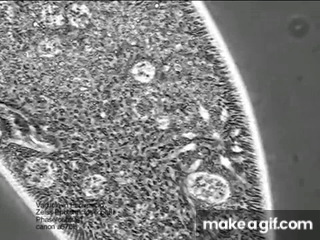This term refer's to water molecules' tendency to stick to one another:
Cohesion
Is osmosis a form of active or passive transport?
Passive
There are many types of molecules which comprise a cell membrane, but the primary molecule type which makes up most of the membrane is:
Phospholipids
Small, mostly uncharged molecules are capable of moving directly across the cell membrane relatively easily from high to low concentration. This form of cell transport is known as:
Simple Diffusion
These are the negatively-charged particles which orbit atomic nuclei and interact to form chemical bonds:
Electrons
Solvation
This is an emergent property of water that arises from water molecules' ability to stick to each other; it creates biologically important interactions at the interface between water and air
Surface Tension
A section of plant tissue is found to have cells with a sugar concentration of roughly 1%. This tissue is placed in sugar water with a sugar concentration of roughly 0.5%. Based on this setup, will the plant tissue gain or lose mass?
Gain
Many types of membrane proteins exist which have many different functions and structural arrangements. Membrane proteins that are fully embedded into and across both sides of the bilayer of the cell membrane are referred to as:
Integral Proteins
GLUT1 is a protein that assists in transporting glucose from the bloodstream into cells. Notably, GLUT1 only functions when transporting glucose down its concentration gradient (from high concentration to low concentration). This means that the type of cell transport carried out by GLUT1 is:
Facilitated Diffusion
Element
According to entropy and the second law of thermodynamics, solutes will always flow from where there is a lot of them to where there is less of them. When this happens, we refer to it as solutes diffusing down their:
Concentration Gradient
Polar
The human organ most directly involved in maintaining the osmotic balance of the blood is the:
Kidney
This is a term for a membrane protein which carries molecules across the cell membrane against their concentration gradient at the cost of ATP:
Pump Protein
Due to a combined effect of the properties of the cell membrane bilayer as well as all of the molecules attached to it or embedded in it (i.e. proteins, etc.), a cell can directly or indirectly control the transport of particular types of molecules and at specific rates. This ability / property of the membrane is known as:
Selective Permeability
Atoms of some elements may share electrons with one another in order to fill their outermost electron shell, and this process creates chemical bonds. What are these chemical bonds called?
Covalent Bonds
These are a special class of channel proteins with the specific function of transporting water molecules more rapidly across cell membranes:
Aquaporins
This is a physical property that describes how much energy is needed to alter the temperature of a substance by one degree Celsius. Water, notably, has a very high value for this property, meaning it takes a lot of energy gain or loss to change water's temperature. What is this property?
Specific Heat Capacity
A root system of a tree is found to have 0.2% dissolved, and the soil is found to have 3.0% dissolved minerals. Based on this information, will the roots of this tree be expected to gain or lose water?
These are a special class of membrane proteins which have been modified to have long sugar chains attached to them, usually allowing them to carry out functions such as cell-to-cell communication. The name for this type of special molecule type is:
Glycoproteins
This is the term for the small, mostly temporary organelles which may be formed to transport large amounts of material at once either into or out of the cell:
Vesicles
Atoms of different elements have nuclei of differing sizes / numbers of protons, and as a result they attract electrons with differing degrees of strength. This property by which an atom of an element may attract additional electrons is known as:
Electronegativity
This is the MOST COMMON kind of pump protein found in humans. It transports ions against their concentration gradients and is necessary for nervous system function
Sodium-Potassium Pumps
This is a property of water (and other liquids) by which the pressure of the liquid's molecules pushing on an object which is less dense than the liquid can cause that object to float; this property/effect is called:
Buoyancy
Turgor pressure
This is the molecule that many cell types will embed into their cell membranes in order to help regulate cell membrane fluidity. At high temperatures, this molecule serves to slow down the flow of molecules in the membrane, and at low temperatures it will act as a "spacer" between adjacent molecules to keep them from becoming stuck in place and impairing cell membrane function. This molecule is known as:
Cholesterol
This gif shows a unicellular protist which lives in freshwater ecosystems. It has a special organelle which helps it maintain its osmotic balance in this environment. What is the name of this special organelle?

Contractile Vacuole
These are weak bonds which may form between partial positive charges and partial negative charges on adjacent molecules:
Hydrogen Bonds
Earlier in this class, we watched a case study video in which a patient was admitted to the hospital from drinking a liter of soy sauce and sustained major brain damage. What was the name of the condition which caused this osmotic disruption and brain damage?
Acute Hypernatremia